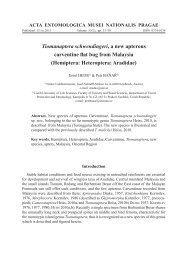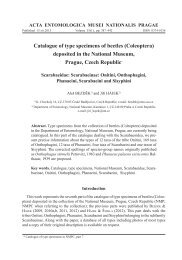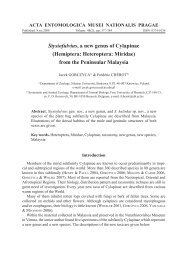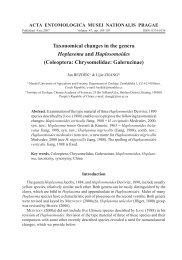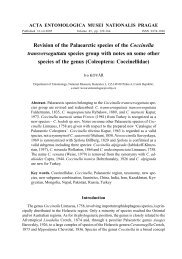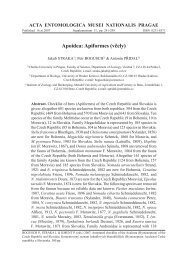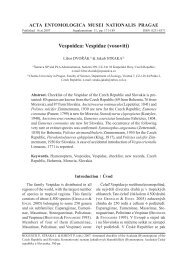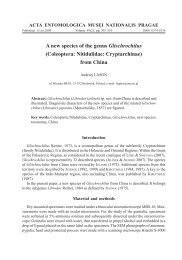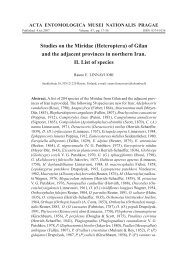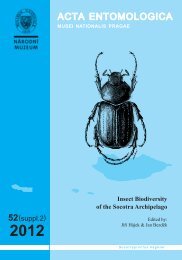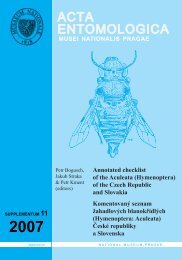(Hemiptera: Heteroptera: Miridae: Phylinae) from Morocco - Acta ...
(Hemiptera: Heteroptera: Miridae: Phylinae) from Morocco - Acta ...
(Hemiptera: Heteroptera: Miridae: Phylinae) from Morocco - Acta ...
You also want an ePaper? Increase the reach of your titles
YUMPU automatically turns print PDFs into web optimized ePapers that Google loves.
ACTA ENTOMOLOGICA MUSEI NATIONALIS PRAGAE<br />
Published 8.xii.2008 Volume 48(2), pp. 419-422 ISSN 0374-1036<br />
A new species of Megalocoleus (<strong>Hemiptera</strong>: <strong>Heteroptera</strong>:<br />
<strong>Miridae</strong>: <strong>Phylinae</strong>) <strong>from</strong> <strong>Morocco</strong><br />
Armand MATOCQ<br />
Muséum national d’Histoire naturelle, Département Systématique & Évolution (Entomologie), C.P. 50,<br />
45 rue Buffon, F-75 231 Paris cedex 05, France; e-mail: matocq.armand@wanadoo.fr<br />
Abstract. Megalocoleus stysi sp. nov. is described <strong>from</strong> <strong>Morocco</strong> and its habitus<br />
and male and female genitalia are illustrated. An amendment to the key for<br />
Megalocoleus Reuter, 1890, is proposed.<br />
Key words. <strong>Heteroptera</strong>, <strong>Miridae</strong>, <strong>Phylinae</strong>, Megalocoleus stysi sp. nov., genitalia,<br />
key, <strong>Morocco</strong><br />
Introduction<br />
The important collection of Eckerlein preserved in the Natural History Museum of Geneva<br />
(MHNG) is essential for the study of numerous Palaearctic mirid species and sometimes<br />
brings surprises. During the study of a large quantity of specimens collectively identifi ed<br />
as ‘Amblytylus’, I encountered a small series of a new species of the genus Megalocoleus<br />
Reuter, 1890.<br />
This genus is strictly Palaearctic (SCHUH 1995, KERZHNER & JOSIFOV 1999). The 24 described<br />
species assigned to it were recently re-examined by MATOCQ (2004), and after establishing<br />
seven synonymies, one new combination, and one restoration of species status, the number<br />
of species belonging to Megalocoleus decreased to 14. Most of them are characterised mainly<br />
by the male genitalia.<br />
The new species is described below, including a modifi cation to the recently published key<br />
to Megalocoleus species (MATOCQ 2004). The species is warmly dedicated to Pavel Štys.<br />
Results<br />
Megalocoleus stysi sp. nov.<br />
(Figs. 1-10)<br />
Type locality. <strong>Morocco</strong>, Kenitra, Foręt de Mamora.<br />
Type material. HOLOTYPE: �, ‘<strong>Morocco</strong> / Kenitra / Forêt de Mamora / 5-V-1967 / Eckerlein leg.’ (MHNG). PARATYPES:<br />
2 �� 6 ��, same data as holotype (MHNG); 1 � 1 �, same data as holotype (coll. Matocq). The 11 specimens of<br />
the type series have lost most of their vestiture; setae can only be observed in places.
420<br />
MATOCQ: A new species of Megalocoleus <strong>from</strong> <strong>Morocco</strong><br />
Fig. 1. Megalocoleus stysi sp. nov. Habitus of male and female.<br />
Description (both sexes). Integument rather mat, body and appendages entirely greyish<br />
yellow except the last segment of rostrum and the last tarsal segments and claws of all legs,<br />
which are black. Dorsal vestiture with two types of setae of unknown distribution (see the<br />
note above), fi ne and adpressed pale setae and semi-erect dark setae observed along lateral<br />
margin of hemelytra and on cuneus). Length (� and �) = 3.8-4.5 mm.<br />
Head short, not elongated (Fig. 2); length of antennal segments: I – 0.35 mm, II –1.1 mm,<br />
III – 0.9 mm, IV – 0.45 mm (Fig. 3). Rostrum reaching the middle of abdominal sternite<br />
VIII.<br />
Pronotum trapezoidal with slightly carinate lateral margin; xyphus concave and carinate.<br />
Hemelytra slightly translucent with more or less darkend spot in the middle (more pronounced<br />
in females); membrane smoky transparent with white veins.<br />
Legs: femora without black spots; tibiae with black spines; tarsi: segments I and II greyish<br />
yellow, segment III and claw black; hind tarsi: segments II and III of hind tarsus subequal in<br />
length (Fig. 4); claws as in Fig. 5.
<strong>Acta</strong> Entomologica Musei Nationalis Pragae, 48(2), 2008 421<br />
Figs. 2-10. Megalocoleus stysi sp. nov. (male holotype: 2 to 8). 2 – head, lateral view; 3 – antenna; 4 – hind tarsus;<br />
5 – claw; 6 – vesica, lateral view; 7 – apex of vesica, different angle; 8 – left paramere; 9 – vagina, dorsal view; 10<br />
– detail of left ring sclerite of vagina.<br />
Genitalia. Male: vesica slender, U-shaped; with a thin, straight and acute apex (Fig. 6);<br />
secondary gonopore removed far <strong>from</strong> apex of vesica (Fig. 7); left paramere as in Fig. 8.<br />
Female: vagina large and oval (Fig. 9). Ring sclerites subtriangular (Fig. 10).<br />
Differential diagnosis. Megalocoleus stysi sp. nov. shows some similarities with M. lunula<br />
(Fieber, 1861) in the colouration and vestiture but differs <strong>from</strong> the latter species in the structure<br />
of the vesica. The vesica of M. stysi sp. nov. is thin with a straight apex and the secondary<br />
gonopore is removed far <strong>from</strong> the apex of the vesica, while the vesica of M. lunula is thicker<br />
with a curved apex and subapically placed secondary gonopore. The vesica of M. stysi sp. nov.<br />
is similar to that of M. krueperi (Reuter, 1879), but the latter species is easily distinguished<br />
by its general shape, short and incrassate antennae, and vestiture (see MATOCQ 2004).<br />
Megalocoleus stysi sp. nov. runs to couplet 12 in the key presented by MATOCQ (2004). A<br />
third choice can be added at that point to accommodate M. stysi sp. nov. in the key. Asterisk<br />
(*) means that an examination of the male genitalia is necessary to identify the species with<br />
certainty.
422<br />
MATOCQ: A new species of Megalocoleus <strong>from</strong> <strong>Morocco</strong><br />
12. Second segment of antenna slender, at least 1.5 mm long. Female: pubescence generally<br />
pale dense and fi ne, dark hairs sparse. Male: pubescence brownish, fl exible, not dense.<br />
Rostrum in both sexes very long, reaching or even surpassing posterior end of abdomen.<br />
Large species. ................................................................ *M. longirostris (Fieber, 1861)<br />
– Second segment of antenna much shorter, 1.1 mm long; apex of rostrum reaching middle<br />
of abdominal segment VIII. ............................................................... *M. stysi sp. nov.<br />
– Second segment of antenna shorter, 1.25 mm long. .................................................... 13<br />
13. Brown pubescence dense, hairs thick; pale pubescence sparse and fi ne. Apex of rostrum<br />
surpassing abdominal segment VIII (male) or reaching its basal quarter (female). Corium<br />
sometimes with a round, more or less pronounced mark. ..... *M. lunula (Fieber, 1861)<br />
– Brown and pale pubescence fi ne and rather dense, evenly distributed. Apex of rostrum<br />
surpassing abdominal segment VIII (male) or reaching its middle (female). Cuneus<br />
sometimes orange. ................................................................... *M. naso (Reuter, 1879)<br />
Etymology. The species is dedicated to Prof. Pavel Štys on the occasion of his 75th birthday<br />
and in recognition of his important contribution to our knowledge of the <strong>Heteroptera</strong>.<br />
Distribution. Northwestern <strong>Morocco</strong>.<br />
Discussion<br />
Specimens of Megalocoleus are commonly mixed in collections with specimens belonging<br />
to other similar genera, in particular with Amblytylus Fieber, 1858 (and vice versa). I have<br />
already mentioned the diffi culties of separating these two and other genera such as Tinicephalus<br />
Fieber, 1858 (MATOCQ 2004), which are due to the insuffi cient defi nition of generic<br />
characters. Megalocoleus stysi sp. nov. exhibits all the external characters previously listed<br />
for the genus in a provisional diagnosis (MATOCQ 2004: 71): the general colouration, shape<br />
of the head, comparative length of the tarsal segments, and morphology of the claws. Only<br />
one character (lateral margin of the pronotum slightly carinate) does not fi t well with the<br />
defi nition of the genus. However, the most important diagnostic character is the form of the<br />
vesica (Figs. 6 and 7).<br />
Acknowledgments<br />
I am very grateful to P. Schwendinger, C. Lienhard and J. Hollier (all MHNG) for the loan<br />
of mirid specimens and kind support during my different stays at MHNG. I would also like<br />
to thank J. Hollier for checking the English text, G. Hodebert (Paris) for the drawing of Fig.<br />
1, and F. V. Konstantinov (St. Petersburg, Russia) and S. Pagola-Carte (Donostia, Spain) for<br />
valuable comments on the manuscript.<br />
References<br />
KERZHNER I. M. & JOSIFOV M. 1999: <strong>Miridae</strong> Hahn, 1933. Pp. 1-577. In: AUKEMA B. & RIEGER Ch. (eds):<br />
Catalogue of the <strong>Heteroptera</strong> of the Palaearctic Region. Volume 3. Cimicomorpha II. The Netherlands Entomological<br />
Society, Amsterdam, xiv + 577 pp.<br />
MATOCQ A. 2004: Revue des espèces attribuées au genre Megalocoleus Reuter, 1890 (<strong>Heteroptera</strong>: <strong>Miridae</strong>). Annales<br />
de la Société Entomologique de France (N. S.) 40: 69-101.<br />
SCHUH R. T. 1995: Plant bugs of the world (Insecta: <strong>Heteroptera</strong>: <strong>Miridae</strong>): Systematic catalog, distributions, host<br />
list, and bibliography. The New York Entomological Society, New York, xii + 1329 pp.



